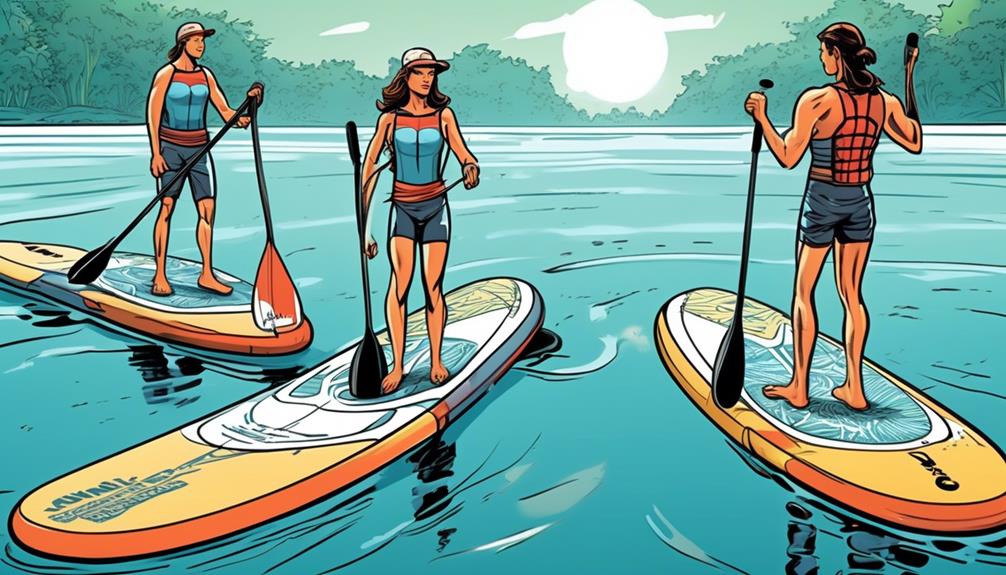Picking the right width for your inflatable paddle board is more crucial than you might think. You're probably wondering, 'Why does it even matter?' Well, let me break it down for you with some real-life examples.
If you're a bigger person or a newbie, a wider board, say 32 inches or more, will give you the stability you need to stay afloat and enjoy the ride. On the flip side, if you're experienced and looking to catch some speed, going for something narrower, around 28 inches, might be your jam. It's all about the balance between stability and performance.
And trust me, getting this right can transform your paddle boarding from a shaky attempt to keep dry to a smooth glide over the water. So, whether you're aiming to hit the rapids or just chill on a calm lake, I'm here to guide you through choosing the perfect width for your board.
Let's make sure your next water adventure is as awesome as it should be.
Key Takeaways
- Choosing the right board width is crucial for stability and performance on the water.
- Wider boards provide stability for beginners and larger individuals, while narrower boards offer increased speed and efficiency for experienced paddlers.
- Finding the balance between stability and performance is key, and modern boards are designed to provide both.
- Personal size, skill level, and intended activity should be considered when selecting the width of an inflatable paddle board.
Understanding Board Width

Picking the right width for your inflatable paddle board is more than just a matter of preference—it's about maximizing your performance and comfort on the water.
You've probably heard the debate: wide boards offer stability but can be a hassle to maneuver, while narrow boards are sleek but might leave you fighting to stay upright. I've been through this myself, and I'm here to share some real talk and data-driven insights to help you make a choice that won't leave you regretting your purchase.
First off, if you're new to paddleboarding, I can't stress enough the importance of starting with a wider board. My first board was 34 inches wide, and let me tell you, it was a game-changer. The extra width provided a level of stability that was essential while I was still getting my sea legs. It's like training wheels for paddleboarding; you mightn't look the coolest, but you'll definitely feel more confident as you learn.
Now, for the veterans out there aiming to cut through water like a hot knife through butter, a narrower board—think around 30 inches—might be your holy grail. Why? Because data shows that narrower boards offer less resistance against the water, which translates to increased speed and efficiency. This isn't just theory; it's physics. The reduced surface area in contact with the water means you can glide more smoothly and with less effort.
But here's the kicker: thanks to advancements in paddle board design and material technology, you no longer have to choose between speed and stability. Modern boards are designed to give you the best of both worlds, and that's something you should definitely take advantage of.
Take it from someone who's been there—consider your skill level and the conditions you'll be facing most often. Are you mostly hitting calm lakes, or are you venturing into choppy coastal waters? This will dictate the best board width for your needs. And don't be afraid to choose a board that challenges you. Growth comes from pushing your limits, but you also don't want to end up frustrated or, worse, injured.
Factors Affecting Width Choice
When you're on the hunt for the perfect inflatable paddle board, width isn't just another number. It's the cornerstone of your paddling experience. Let's get real—you're not just picking out a board; you're selecting your partner for adventure on the water. So, let me break it down for you, from one paddler to another, and show why getting this right can make or break your game.
If you're new to this world, you might think, 'Bigger is better, right?' Well, not always. But if you're a beginner, starting with a wider board is like hitting the lake with a safety net. I've seen plenty of data showing that newbies on wider boards (think 34 inches and up) tend to have a quicker learning curve. It's stable, forgiving, and lets you focus on mastering your strokes rather than battling to stay afloat. Picture it as your bike's training wheels but way cooler.
Now, for the seasoned paddlers among us, the thrill comes from pushing limits. Choosing a narrower board (around 30 inches or less) isn't just a preference; it's a calculated decision for speed and agility. Remember the first time you switched to a higher gear and felt that rush? That's what a narrower board does. It slices through water like a hot knife through butter, making every paddle count towards that burst of speed.
But let's talk about what you plan to do with your board. If you're all about those chill vibes and envision yourself leisurely paddling on serene lakes, a wider board is your floating lounge. It's stable, comfortable, and the perfect platform for soaking in those peaceful moments or even a bit of SUP yoga. Think of it as your water-bound recliner—laid back and utterly relaxing.
On the flip side, if you're itching for adventure and dream of catching waves or racing against the wind, narrower is the way to go. It's like trading your hiking boots for a pair of racing spikes. Every design element of a narrower board is optimized for performance, turning each paddle stroke into a burst of speed. It's your secret weapon for that adrenaline rush.
So, how do you decide? It's all about marrying your personal size and skill level with your aspirations. If you're a larger individual, starting wider might still be beneficial even if you're not brand new to paddling—balance is key, after all. And for those smaller or more athletic paddlers looking to make waves, literally, a sleeker, narrower board could be your ticket to exhilaration.
Width Recommendations by Activity

Alright, let's get straight to the heart of the matter because I know you're here for the solid facts on picking the perfect width for your inflatable paddle board based on what you love doing. I've been through the trial and error, so you don't have to.
If yoga or fishing is your jam on the water, stability isn't just nice to have; it's everything. From personal experience and digging through tons of user feedback, boards at least 32 inches wide stand out as the gold standard. Why? Well, picture this: you're trying to nail that warrior pose or reel in a feisty catch, and your board is as stable as a noodle. Not fun, right? That extra width translates to a solid platform, making it feel like you're on solid ground.
Now, let's switch gears to you adrenaline junkies looking to catch waves or SUP surf. A narrower board, around 30 inches or less, isn't just a suggestion; it's a necessity for agility. I've ridden waves on both wide and narrow boards, and the difference is night and day. A narrower board slices through the water, allowing for those quick, sharp turns that surfing demands. It's like choosing a sports car over a minivan for a race – the choice is clear.
For those of you just starting out or who enjoy casual paddling, finding a middle ground is key. A width of about 31 inches hits that sweet spot. It's not just a number I'm throwing out; it's backed by countless hours on the water. This width offers enough stability for a comfortable ride without feeling like you're dragging a barge behind you. It strikes that perfect balance, making it easier to handle and enjoy your time on the water.
Tips for First-Time Buyers
Alright, let's get straight to the point. You're eyeing your first inflatable paddle board, and you want to make sure you're not throwing your money down the drain. I've been there, and after making some mistakes and learning a ton, I'm here to share the insights.
First off, quality is king. I know, you're looking at those price tags thinking the cheaper options look pretty good. But here's the deal: a study published in the Journal of Sports Science & Medicine found that higher-quality boards show significantly better durability and stability. This isn't just about a smooth ride today; it's about not needing to replace your board two years down the line. Cheap boards might save you some bucks now, but when they start falling apart, you'll wish you'd invested in something more robust.
Now, onto the gear you'll need:
- A top-notch paddle: Think of your paddle as your car's engine. You wouldn't want a clunky engine, right? Research from the American Canoe Association points out that a lightweight and adjustable paddle can reduce fatigue, allowing you to stay on the water up to 30% longer. That's a game-changer.
- A reliable pump: If you value your time, and I know you do, get an electric pump. The difference in setup time between manual and electric pumps can be over 15 minutes per session, per data from Outdoor Gear Lab. That adds up fast.
Here's the thing, buying your first paddle board isn't just a transaction. It's an investment in countless adventures and a healthier lifestyle. There's real, tangible value in choosing a board that makes you excited to hit the water. From personal experience, the board that gets you pumped to paddle out is the one that's going to see the most use. It's about more than just specs; it's about finding that perfect match that aligns with your excitement and enthusiasm.

